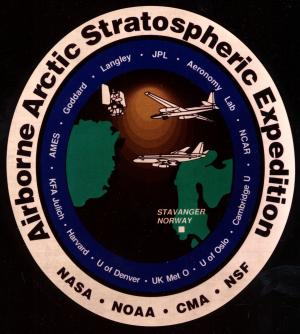Airborne Arctic Stratospheric Expedition

The Airborne Arctic Stratospheric Expedition (AASE) campaign was a joint mission by NASA, NOAA, and the National Science Foundation (NSF). While this is one overarching campaign, AASE has been broken into two sub-campaigns: AASE and AASE-II namely, which each have their own mission goals. AASE’s primary goal was to study the production and loss mechanism of ozone in the north polar stratospheric environment. This was after it was realized that ozone loss on either side of the 1987 Antarctic vortex during AAOE occurred under conditions found in the Arctic vortex. Along with this, AASE aimed to study the effect of ozone distribution of the Arctic polar vortex as well as the cold temperatures associated with the formation of Polar Stratospheric Clouds. AASE-II aims to answer three science questions. First, AASE-II asks: will significant erosion of stratospheric ozone occur over the Arctic as stratospheric chlorine levels increase during the next decade? Second, AASE-II sought to understand what the causes of mid-latitude stratospheric ozone decreases in late fall through early summer are. This objective comes from the observations of ground and satellite observations the decade prior to the campaign. Finally, due to the eruption of Mt. Pinatubo in June 1991, AASE-II aimed to address the effect volcanoes have on the chemical processes that govern stratospheric ozone. Specifically, this campaign questions if volcanic aerosols could modify depletion of stratospheric ozone associated with industrial halocarbons?
In order to accomplish these goals and answer these questions, AASE deployed the NASA DC-8 aircraft, NASA ER-2 aircraft, balloon sondes, and used imagery from satellites. These payloads and instruments were used for both AASE and AASE-II. Flights for AASE (including test flights) were conducted from December 1988 to February 1989, while flights for AASE-II (including test flights) were conducted from August 1991 to March 1992. The ER-2 was equipped with 13 instruments during AASE. Three instruments among those were the NOAA NO/NOy Instrument (NOAA NOy), the Multiple Axis Resonance Fluorescence Chemical Conversion Detector for ClO and BrO (ClO/BrO), and the Dual-Beam UV-Absorption Ozone Photometer (NOAA O3 Classic). The NOAA NOy was responsible for collecting data on NO volume mixing ratio in parts per billion (ppb), as well as NOy volume mixing ratio in ppb. As the name suggests, the ClO/BrO took measurements of BrO and ClO mixing ratio in ppb. The NOAA O3 Classic was enlisted on this campaign to take measurements of ozone in the atmosphere in ppb. The NASA DC-8 aircraft was equipped with 14 instruments. Three of those instruments were the Differential Absorption Lidar (DIAL), the Whole Air Sampler (WAS (NCAR)), and the NOAA Lyman-Alpha Total Water Hygrometer (NOAA TW). The DIAL recorded data on infrared (IR) aerosol depolarization percentages, IR atmospheric scattering ratio, ozone mixing ratio in ppb by volume, VIS aerosol depolarization percentages, and VIS atmospheric scattering ratio. The WAS (NCAR) collected data on mixing ratios of CO2, CH4, CO, N2O, CF2Cl2, CFCl3, C2F3Cl3, and CH3CCl3. The NOCAR (NCAR/NOAA) NO/NOy instrument made in situ observations at DC-8 flight levels which were found to record NOy falling gravitationally on particles formed at higher altitudes. Finally, the NOAA TW collected information about the H2O volume mixing ratio in parts per million (ppm). For AASE, the balloon sondes were used to collect data on air temperature, dew point depression, and wind speed.
The ER-2 aircraft was equipped with 18 instruments for AASE-II. Three of those instruments include the Microwave Temperature Profiler (MTP), the Argus Tunable Diode Laser Instrument (ARGUS), and the Aircraft Laser Infrared Absorption Spectrometer (ALIAS). The MTP collected data on atmospheric temperature and potential air temperature. The ARGUS measured N2O mixing ratio in ppb. Finally, the ALIAS collected data on N2O, CH4, HNO3, HCL, and H2O. The DC-8 aircraft was equipped with 16 instruments. Three of the instruments among the 16 include the Differential Absorption Carbon Monoxide Measurement (DACOM), the Whole Air Sampler (WAS (UCI)), and the Forward Scattering Spectrometer Probe (FSSP). The DACOM recorded measurements on the carbon monoxide mixing ratio (ppb), methane mixing ratio (ppb), nitrous oxide mixing ratio (ppb), and the carbon dioxide mixing ratio (ppm). The WAS (UCI) collected data on hydrocarbons/halocarbons in the atmosphere. While the FSSP collected concentrations and distribution of aerosol size. The balloon sondes for AASE-II collected temperature, ozone partial pressure, wind speed, and wind direction.